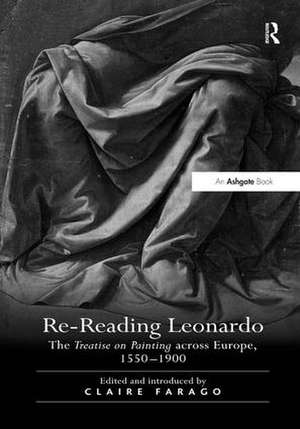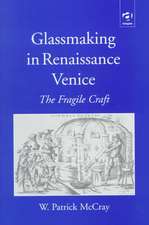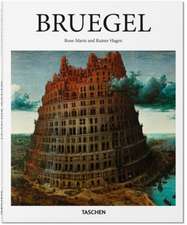Re-Reading Leonardo: The Treatise on Painting across Europe, 1550–1900
Editat de Claire Faragoen Limba Engleză Hardback – 26 mar 2009
Preț: 1008.19 lei
Preț vechi: 1342.26 lei
-25% Nou
Puncte Express: 1512
Preț estimativ în valută:
193.01€ • 200.62$ • 160.02£
193.01€ • 200.62$ • 160.02£
Carte tipărită la comandă
Livrare economică 06-20 februarie 25
Preluare comenzi: 021 569.72.76
Specificații
ISBN-13: 9780754665328
ISBN-10: 0754665321
Pagini: 652
Dimensiuni: 174 x 246 x 42 mm
Greutate: 1.72 kg
Ediția:1
Editura: Taylor & Francis
Colecția Routledge
Locul publicării:Oxford, United Kingdom
ISBN-10: 0754665321
Pagini: 652
Dimensiuni: 174 x 246 x 42 mm
Greutate: 1.72 kg
Ediția:1
Editura: Taylor & Francis
Colecția Routledge
Locul publicării:Oxford, United Kingdom
Cuprins
Contents: Introduction: the historical reception of Leonardo da Vinci's abridged Treatise on Painting, Claire Farago. Section 1 The Italian Reception: What might Leonardo's own Trattato have looked like? And what did it actually look like up to the time of the editio princeps?, Martin Kemp and Juliana Barone; Leonardo and the Florentine Academy, Robert Williams; Who abridged Leonardo da Vinci's Treatise on Painting?, Claire Farago; On the movement of figures in some early apographs of the abridged Trattato, Michael Cole; Zaccolini and the Trattato della Pittura of Leonardo da Vinci, Janis C. Bell; The first Italian publication of the Treatise on Painting: book culture, the history of art, and the Naples edition of 1733, Thomas Willette. Section 2 The French Reception: The Vita of Leonardo da Vinci in the Du Fresne edition of 1651, Catherine M. Soussloff; Poussin as engineer of the human figure: the illustrations for Leonardo's Trattato, Juliana Barone; 'A chaos of intelligence': Leonardo's Traité and the perspective wars at the Académie Royale, Martin Kemp; Perspective and the Paris Academy, J.V. Field; Leonardo's theory of aerial perspective in the writings of André Félibien and the paintings of Nicolas Poussin, Pauline Maguire Robison; Between academicism and its critics: Leonardo da Vinci's Traité de la Peinture and 18th-century French art theory, Thomas Kirchner. Section 3 The Spanish Reception: The Trattato in 17th- and 18th-century Spanish perspective and art theory, Javier Navarro de Zuvillaga; Pacheco, Velázquez, and the legacy of Leonardo in Spain, Charlene Villaseñor Black. Section 4 The Dutch, German and Flemish Reception: The reception of Leonardo da Vinci's Trattato della Pittura or Traité de la Peinture in 17th-century Northern Europe, Michèle-Caroline Heck; 'This art embraces all visible things in its domain': Samuel van Hoogstraaten and the Trattato della Pittura, Thijs Weststeijn; Rubens and Leonardo on motion: figures, inscriptions, and te
Notă biografică
Claire Farago is Professor of Early Modern Art, Theory, and Criticism at the University of Colorado at Boulder, USA.
Recenzii
'This collection - concerning the historical fortunes and effects of Leonardo's Treatise on Painting - is long overdue. Importantly, this volume turns our attention to the reception of Leonardo in a pan-European context, making the treatise of interest not only to Renaissance and early modern art historians, but to those who study later periods.' Lyle Massey, University of California, Irvine, USA
'These essays offer a well-rounded analysis of the reception of Leonardo's Treatise by tracing trajectories of its development through a variety of cultural, historical, social, technical, critical, nationalistic, and reappropriated forms. It is the first book to address, within its historical framework, the diverse network of cultural interchange about the value of ideas associated (directly and remotely) with Leonardo da Vinci and the traditions of his time. A compelling feature of this approach is the way in which it involves this diverse network of professionals over the centuries, including not only painters, sculptors, illustrators, printmakers, and architects, but also biographers, theorists, natural philosophers, translators, astronomers, publishers, engineers, theologians, aristocrats, lawyers, politicians, entrepreneurs, and collectors.' Matthew Landrus, Rhode Island School of Design, USA
’The amount of information this book imparts is quite astonishing...’ Renaissance Quarterly
'... impressive, generously illustrated collection of essays... a rich analysis of art instruction, the rise of academies, and conflicting concepts of artistic authority and integrity during the early modern period.' CAA Reviews
'... a well-organized and comprehensive cross-cultural study of the most significant text on painting... That authors reference each other's work attests to the extensive planning and throughtfulness that went into the production of this volume... provides excellent analysis as well as questions and avenues for future research... Amply illustrated by manuscript pages and details, this volume also has helpful diagrams such as the stemma of Leonardo's manuscript and a comprehensive bibliography of printed editions. Just as his treatise and its variations attracted a wide audience, Re-Reading Leonardo will appeal to a broad range of scholars from Renaissance and beyond. With the wealth of information found within, this well-written book is a must for every historian's library.' Sixteenth Century Journal
'These essays offer a well-rounded analysis of the reception of Leonardo's Treatise by tracing trajectories of its development through a variety of cultural, historical, social, technical, critical, nationalistic, and reappropriated forms. It is the first book to address, within its historical framework, the diverse network of cultural interchange about the value of ideas associated (directly and remotely) with Leonardo da Vinci and the traditions of his time. A compelling feature of this approach is the way in which it involves this diverse network of professionals over the centuries, including not only painters, sculptors, illustrators, printmakers, and architects, but also biographers, theorists, natural philosophers, translators, astronomers, publishers, engineers, theologians, aristocrats, lawyers, politicians, entrepreneurs, and collectors.' Matthew Landrus, Rhode Island School of Design, USA
’The amount of information this book imparts is quite astonishing...’ Renaissance Quarterly
'... impressive, generously illustrated collection of essays... a rich analysis of art instruction, the rise of academies, and conflicting concepts of artistic authority and integrity during the early modern period.' CAA Reviews
'... a well-organized and comprehensive cross-cultural study of the most significant text on painting... That authors reference each other's work attests to the extensive planning and throughtfulness that went into the production of this volume... provides excellent analysis as well as questions and avenues for future research... Amply illustrated by manuscript pages and details, this volume also has helpful diagrams such as the stemma of Leonardo's manuscript and a comprehensive bibliography of printed editions. Just as his treatise and its variations attracted a wide audience, Re-Reading Leonardo will appeal to a broad range of scholars from Renaissance and beyond. With the wealth of information found within, this well-written book is a must for every historian's library.' Sixteenth Century Journal
Descriere
Examining the historical reception of Leonardo's Treatise on Painting in a cross-cultural framework, this collection represents the first attempt to chart the influence of the work, an important resource for the academic instruction of artists through four centuries and widely read by intellectuals and lovers of art for three centuries, when Leonardo's ideas and art were known almost exclusively through his book. The volume, dealing specifically with the reception and influence of the artist's ideas, takes Leonardo studies to a new level of historical inquiry.















